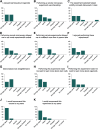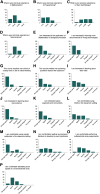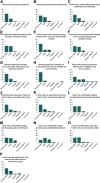Internet-Connected Cortical Organoids for Project-Based Stem Cell and Neuroscience Education
- PMID: 38016807
- PMCID: PMC10755643
- DOI: 10.1523/ENEURO.0308-23.2023
Internet-Connected Cortical Organoids for Project-Based Stem Cell and Neuroscience Education
Abstract
The introduction of Internet-connected technologies to the classroom has the potential to revolutionize STEM education by allowing students to perform experiments in complex models that are unattainable in traditional teaching laboratories. By connecting laboratory equipment to the cloud, we introduce students to experimentation in pluripotent stem cell (PSC)-derived cortical organoids in two different settings: using microscopy to monitor organoid growth in an introductory tissue culture course and using high-density (HD) multielectrode arrays (MEAs) to perform neuronal stimulation and recording in an advanced neuroscience mathematics course. We demonstrate that this approach develops interest in stem cell and neuroscience in the students of both courses. All together, we propose cloud technologies as an effective and scalable approach for complex project-based university training.
Keywords: STEM education; brain organoids; internet-of-things; neuroscience; organoids; stem cells.
Copyright © 2023 Elliott et al.
Conflict of interest statement
M.A.M.-R. is a cofounder of Paika, a company for remote people-to-people interactions. All other authors declare no competing financial interests.
Figures







Update of
-
Internet-connected cortical organoids for project-based stem cell and neuroscience education.bioRxiv [Preprint]. 2023 Jul 15:2023.07.13.546418. doi: 10.1101/2023.07.13.546418. bioRxiv. 2023. Update in: eNeuro. 2023 Dec 26;10(12):ENEURO.0308-23.2023. doi: 10.1523/ENEURO.0308-23.2023. PMID: 37503236 Free PMC article. Updated. Preprint.
Similar articles
-
Internet-connected cortical organoids for project-based stem cell and neuroscience education.bioRxiv [Preprint]. 2023 Jul 15:2023.07.13.546418. doi: 10.1101/2023.07.13.546418. bioRxiv. 2023. Update in: eNeuro. 2023 Dec 26;10(12):ENEURO.0308-23.2023. doi: 10.1523/ENEURO.0308-23.2023. PMID: 37503236 Free PMC article. Updated. Preprint.
-
Evaluation of Neurotoxicity With Human Pluripotent Stem Cell-Derived Cerebral Organoids.Curr Protoc. 2023 Apr;3(4):e744. doi: 10.1002/cpz1.744. Curr Protoc. 2023. PMID: 37068185
-
Differentiation of brain and retinal organoids from confluent cultures of pluripotent stem cells connected by nerve-like axonal projections of optic origin.Stem Cell Reports. 2022 Jun 14;17(6):1476-1492. doi: 10.1016/j.stemcr.2022.04.003. Epub 2022 May 5. Stem Cell Reports. 2022. PMID: 35523177 Free PMC article.
-
Pluripotent stem cell-derived kidney organoids: An in vivo-like in vitro technology.Eur J Pharmacol. 2016 Nov 5;790:12-20. doi: 10.1016/j.ejphar.2016.06.059. Epub 2016 Jul 1. Eur J Pharmacol. 2016. PMID: 27375081 Review.
-
Microinstrumentation for Brain Organoids.Adv Healthc Mater. 2024 Aug;13(21):e2302456. doi: 10.1002/adhm.202302456. Epub 2024 Jan 26. Adv Healthc Mater. 2024. PMID: 38217546 Review.
Cited by
-
Self-Organizing Neural Networks in Organoids Reveal Principles of Forebrain Circuit Assembly.bioRxiv [Preprint]. 2025 May 2:2025.05.01.651773. doi: 10.1101/2025.05.01.651773. bioRxiv. 2025. PMID: 40654898 Free PMC article. Preprint.
-
Application of a high-density microelectrode array assay using a 3D human iPSC-derived brain microphysiological system model for in vitro neurotoxicity screening of environmental compounds.Arch Toxicol. 2025 Jul;99(7):2917-2935. doi: 10.1007/s00204-025-04043-x. Epub 2025 Apr 28. Arch Toxicol. 2025. PMID: 40293475 Free PMC article.
-
Internet-enabled lab-on-a-chip technology for education.Sci Rep. 2024 Jun 22;14(1):14364. doi: 10.1038/s41598-024-65346-0. Sci Rep. 2024. PMID: 38906940 Free PMC article.
-
Open and remotely accessible Neuroplatform for research in wetware computing.Front Artif Intell. 2024 May 2;7:1376042. doi: 10.3389/frai.2024.1376042. eCollection 2024. Front Artif Intell. 2024. PMID: 38756757 Free PMC article.
-
Gamifying cell culture training: The 'Seru-Otchi' experience for undergraduates.Heliyon. 2024 Apr 27;10(9):e30469. doi: 10.1016/j.heliyon.2024.e30469. eCollection 2024 May 15. Heliyon. 2024. PMID: 38737237 Free PMC article.
References
-
- Accorsi A, Williams MM, Ross EJ, Robb SM, Elliott SA, Tu KC, Alvarado AS (2017) Hands-on classroom activities for exploring regeneration and stem cell biology with planarians. Am Biol Teacher 79:208–223. 10.1525/abt.2017.79.3.208 - DOI
-
- Adewole DO, Struzyna LA, Burrell JC, Harris JP, Nemes AD, Petrov D, Kraft RH, Chen HI, Serruya MD, Wolf JA, Cullen DK (2021) Development of optically controlled “living electrodes” with long-projecting axon tracts for a synaptic brain-machine interface. Sci Adv 7:eaay5347. 10.1126/sciadv.aay5347 - DOI - PMC - PubMed
-
- Alsamhi SH, Gupta SK, Rajput NS (2016) Performance evaluation of broadband service delivery via tethered balloon technology. In: 2016 11th International Conference on Industrial and Information Systems (ICIIS), pp 133–138. IEEE. Dec 3–4, 2016 in Roorkee, India.10.1109/ICIINFS.2016.8262921 - DOI
-
- Bajek A, Drewa T (2011) Should we teach regenerative medicine during undergraduate education? Stem Cell Stud 1:e14. 10.4081/scs.2011.e14 - DOI
